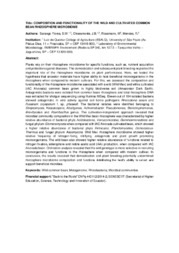Composition and functionality of the wild and cultivated common bean rhizosphere microbiome.
Composition and functionality of the wild and cultivated common bean rhizosphere microbiome.
Author(s): FLORES, S. W. S.; CHIARAMONTE, J. B.; ROSSMANN, M.; MENDES, R.
Summary: Abstract: Plants rely on their rhizosphere microbiome for specific functions, such as, nutrient acquisition and protection against diseases. The domestication and subsequent plant breeding neglected the important role of the rhizosphere microbiome on plant performance. Here, we tested the hypothesis that ancestor materials have higher ability to host beneficial microorganisms in the rhizosphere when compared to modern cultivars. For this, we assessed the composition and functionality of the rhizosphere microbiome associated with a wild (Wild Mex) and with a cultivated (IAC Alvorada) common bean grown in highly biodiverse soil (Amazonian Dark Earth). Antagonistic bacteria were isolated from common bean rhizosphere and total rhizosphere DNA was extracted for shotgun sequencing using Illumina MiSeq. Eleven out of 104 isolated bacteria showed antagonistic in vitro activity against soil borne pathogens Rhizoctonia solani and Fusarium oxysporum f. sp. phaseoli. The bacterial isolates were identified belonging to Streptomyces, Kitasatospora, Alcaligenes, Achromobacter, Pseudomonas, Stenotrophomonas, Brevibacillus and Paenibacillus genus. The cultivation-independent approach revealed that microbial community composition in the Wild Mex bean rhizosphere was characterized by higher relative abundance of bacterial phyla Acidobacteria, Verrucomicrobia, Gemmatimonadetes and fungal phylum Glomeromycota when compared with IAC Alvorada cultivated bean, which showed a higher relative abundance of bacterial phyla Firmicutes, Planctomycetes, Deinococcus-Thermus and fungal phylum Ascomycota. Wild Mex rhizosphere microbiome showed higher relative frequency of nitrogen-fixing, nitrifying, antagonists and plant growth promoting microorganisms. The wild bean also showed higher relative abundance of functions related to nitrogen fixation, siderophore and indole acetic acid (IAA) production, when compared with IAC Alvorada bean. Ordination analysis revealed that the wild genotype is more selective in recruiting microorganisms and functions in the rhizosphere when compared with modern cultivar. In conclusion, the results revealed that domestication and plant breeding potentially undermined rhizosphere microbiome composition and functions debilitating the host?s ability to select and support beneficial microbes.
Publication year: 2015
Types of publication: Abstract in annals or event proceedings
Unit: Embrapa Environment
Keywords: Metagenome, Metagenomics, Microbial communities, Rhizobacteria, Wild common bean
Observation
Some of Embrapa's publications are published as ePub files. To read them, use or download one of the following free software options to your computer or mobile device. Android: Google Play Books; IOS: iBooks; Windows and Linux: Calibre.
Access other publications
Access the Agricultural Research Database (BDPA) to consult Embrapa's full library collection and records.
Visit Embrapa Bookstore to purchase books and other publications sold by Embrapa.

